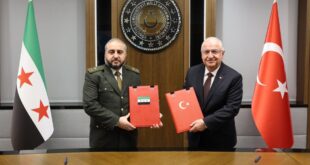EL FASHER, Sudan — Myriam Ibrahim, a tall quiet 28-year-old clad in a bright blue robe, thought she had seen it all. Three years of violence since the Darfur conflict erupted during which her town was invaded twice.
The days in hiding as militia roamed the fields, preventing her from planting crops and making her family dependent on food relief.
But she faced a new calamity last month when she gave birth to triplets.
“I wasn’t expecting it, it was so difficult,†she said, recalling how she spent nearly 24 hours in labour in her hut, assisted only by a midwife.
The lack of food, stress and no outside support meant that she had no milk for the newborns. They were on the verge of starvation when a doctor from the United Nations Children’s Fund found them two weeks ago.
Fayrous would qualify as a small baby in normal conditions, yet she is the biggest of the three sisters, weighing 2.3 kilogrammes when she was two weeks old and was brought 50 kilometres south to a feeding centre in El Fasher, the capital of North Darfur.
Her sister Fardous is smaller. As for the smallest, Fawzia, whose head seems huge in contrast to her tiny trunk and twig-like arms and legs covered by distended skin, she weighed a mere 1.5 kilogrammes on arrival at the centre.
“At least one or two of them would have died of malnutrition within a few days if they hadn’t come here,†said Afaf Briena, a nutritionist with UNICEF who is monitoring the babies’ progress at the government-run clinic.
More than 180,000 people have died in Darfur as a result of the violence that flared in 2003. Most of the victims are women and children who died of malnutrition and disease linked to the conflict, humanitarian workers say.
While a massive effort by aid organisations dramatically reduced hunger and malnutrition in Darfur last year from 22 to 12 per cent of the population, the threat has boomed again in northern Darfur.
Increased infighting between Darfurian rebel groups has recently cut off entire areas from international aid. That, and the lack of funding, could severely threaten the food supply to more than 100,000 people during the “hunger gap†that traditionally afflicts this vast arid region of western Sudan during the July-September rainy season, when there are no crops.
At El Fasher’s feeding centre, the effects are already apparent. “Our number of cases has more than doubled since early May,†said Jamal Abdallah, the Sudanese doctor who runs the clinic. “There isn’t a single free space,†he said, touring the facility where some 40 beds host mothers and their diminished infants.
“This place is like a prison. We control what they eat and drink, who comes in, everything,†Abdallah said as he moved through the ward for the most serious cases. A large painted Mickey Mouse smiles from the wall of the red room presenting an absurd contrast with the babies, who lay in a deep sleep next to their mothers, or sat motionless, eyes staring emptily.
“Children in this region are taught to be quiet, and anyhow, hunger has sucked most of the life out of them,†the doctor said to explain the eery silence that reigns in a clinic full of babies.
A tube in each infant’s hand administers antibiotics and other medicines because many are afflicted with severe diseases including maliaria or tuberculosis, the doctor said. A second tube through the nose is for feeding liquid proteins, because malnutrition has sapped the infants of the energy to eat and their organs have become unable to process normal baby food.
“In phase 1, babies don’t gain weight, we just turn them back into human beings, so they can eat and cry again,†Abdallah said.
A mother walked by, distributing dry dates to nurses and the other mothers. The doctor said a woman traditionally makes such an offering to thank clinic personnel when her baby is ready to be discharged. “On average, only one baby dies each week,†Abdallah said.
The triplets stayed in a separate room for infants under six-month-old because at that age they are particularly vulnerable to disease. All had gained sufficient weight during their two weeks of treatment and were ready to be discharged.
“I have to go home soon, I have three other children to look after,†Ibrahim said. Though she did not come from a refugee camp, like most of the mothers at the clinic, Ibrahim is from one of the ethnic African tribes that have suffered most at the hands of the Arab militia in Darfur.
In the past, Ibrahim each day made a journey of several hours by donkey to and from the plot of land she cultivated, but the ride became too dangerous and she hasn’t planted crops this year.
The mother of six, who hails from the comparatively safe town of Mallit, north of El Fasher, said she lived on food distributed by international aid agencies because her husband had married a second younger wife and had stopped supporting her.
Margaret Schenkal, a Swiss nurse who provides assistance to the feeding centre, said she would provide the mother with a goat so that she could give the milk to the triplets.
“It should do for the first six months, but what will they eat after that?†the nurse said.
 Eurasia Press & News
Eurasia Press & News



